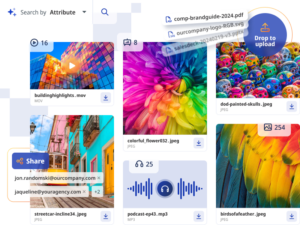What Is Watermarking and Why Does It Matter?
Watermarking Examples – How to Protect Your Digital Assets
In today’s digital-first world, content theft, brand misuse, and unauthorized asset distribution happen more often than you think. Whether you’re a brand, business, or creative team, your digital assets need protection—and watermarking is one of the most effective tools to do just that.
Watermarking is the process of embedding a unique identifier—whether a logo, text, pattern, or invisible digital marker—into an asset to assert ownership and prevent unauthorized use.
Think of it as a digital security stamp that tells the world:
- This content belongs to us.
- Unauthorized use is not allowed.
- If misused, we can track and claim ownership.
How Watermarking Protects Businesses and Brands
Watermarking isn’t just about protecting images—it extends across documents, videos, music, and more. Here’s how businesses across industries leverage watermarking:
Stock Photography and Visual Branding
Stock image websites like Shutter-stock and Getty Images overlay semi-transparent watermarks on every image to prevent unauthorized downloads. Only paid customers get access to high-resolution, unmarked versions.
Example: A media agency looking for licensed content browses Shutter-stock. Every image is watermarked until they purchase the rights, ensuring only authorized users can access high-quality assets.
Corporate Document Security
Legal contracts, confidential business reports, and proprietary documents often include watermarks that say “Confidential” or “Draft” to prevent premature or unauthorized distribution.
Example: A Fortune 500 company watermarks all internal financial reports to prevent leaks before earnings are officially published.
Video Content Protection and Streaming Services
Major streaming platforms, sports broadcasters, and video production companies use forensic watermarking to track leaks and unauthorized distribution.
Example: Netflix and HBO embed invisible digital watermarks in preview versions of movies and shows. If a leak occurs, they can trace it back to the original source.
Music and Audio Watermarking
Record labels and streaming platforms use inaudible watermarks to protect intellectual property and detect piracy.
Example: A record label distributes early versions of an album to journalists with forensic watermarking. If the tracks leak before release, the label can identify exactly which journalist shared the files.
Digital Document Watermarking for Contracts and Sensitive Files
Companies watermark PDFs, legal agreements, and business proposals to prevent unauthorized modifications or misrepresentation.
Example: A real estate firm watermarks all contract drafts so that clients don’t sign an outdated version of an agreement.
The Hidden Risks of Not Watermarking Your Digital Assets
Failing to watermark your assets opens the door to serious business risks, including:
- Unauthorized use. Your content could be stolen and used without credit or permission.
- Brand misrepresentation. Third parties could misuse your brand assets, damaging your reputation.
- Revenue loss. If you sell images, music, or videos, leaks could cost you thousands (or millions) in lost revenue.
- Legal battles. Proving content ownership without a watermark is more difficult in court.
If your assets are valuable, they need to be protected.
Best Practices for Watermarking Digital Assets
To ensure maximum protection and usability, businesses should follow these proven watermarking strategies:
- Choose the right type of watermark. Visible or invisible? Semi-transparent or embedded? Each serves different needs.
- Balance visibility with usability. Make the watermark noticeable but not intrusive (especially for preview versions).
- Position your watermark strategically. Placing it in a corner makes it easy to crop out, so consider centring it or using a repeating pattern.
- Use AI-driven automation. Large-scale organizations automate watermarking to apply it instantly across thousands of assets.
- Combine watermarking with metadata tracking. Metadata can store hidden ownership details, adding another layer of security.
A single watermark isn’t enough—businesses should integrate multiple layers of digital asset security for full protection.

How Watermarking Connects With Digital Asset Management (DAM)
While watermarking is essential for security, it’s not enough on its own. If your team is still managing assets through messy folders, emails, and outdated systems, watermarking won’t solve the deeper issue: organizational chaos.
This is where digital asset management (DAM) comes in.
A DAM system centralizes all brand assets, ensuring:
- Watermarked and unmarked assets are stored in one secure location.
- Teams access only approved, up-to-date content.
- Permissions prevent unauthorized downloads or edits.
- Version control eliminates duplicates and outdated files.
- Search and metadata tagging make finding assets instant.
Without a structured DAM, businesses struggle with asset control, tracking, and security—even if watermarking is used.
How Organizations Use DAM + Watermarking for Maximum Security
Marketing Teams Ensuring Brand Consistency
Brands managing hundreds of assets per campaign need control over which images, videos, and graphics are used externally.
DAM + Watermarking: Marketers store final campaign assets in DAM with watermark protections for external previews.
Legal and Compliance Teams Preventing Leaks
Corporations handling confidential contracts and sensitive business documents must control who can access, edit, and share files.
DAM + Watermarking: Legal teams apply watermarking + permission controls so documents are accessible only by approved users.
Media and Entertainment Companies Tracking Unauthorized Use
Streaming services, film studios, and media agencies need a way to trace leaks and content distribution.
DAM + Watermarking: Media companies use forensic watermarking inside a DAM to track video assets even after they’re distributed.
Future-Proofing Digital Content With DAM-Powered Security
- The digital landscape is expanding faster than ever, and securing brand assets is no longer optional—it’s a business necessity.
- A structured DAM system, combined with watermarking and AI-powered metadata tracking, ensures content protection, brand consistency, and streamlined workflows.
- If your team is juggling assets across multiple tools and folders, it’s time to upgrade to a modern, AI-driven DAM solution.
- Ready to optimize and secure your digital assets? Discover how ASMBL’s DAM capabilities keep your content organized, searchable, and protected.



